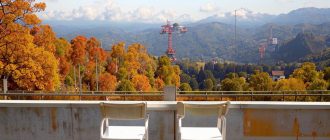
President of Pro-Vision, author of the Vinogradov.story community
«Among Russia’s natural sights, deserts can be counted on the fingers — geography and climate have an effect. And those few that exist are more like sands, dunes and dunes, rather than deserts in the usual sense. And yet each of these locations deserves attention, if only simply because it is not like anything else around. Where to look for a desert in Russia, I will tell you below».
Sary-Kum, Dagestan
20 kilometers from Makhachkala, in the foothills of Narat-Tyube, is one of the world’s largest barchans — Sary-Kum. Inferior in size to its Saharan «brother», it seems to be an alien surrounded by the Caucasus ridges, which makes it mesmerizing.
It is not known exactly how the barchan appeared in this not at all desert landscape. But the legend says that tons of sand were brought here by a powerful hurricane. Even those who have never been to Dagestan must have seen Sary-Kum: it played the role of Turkestan sands in «White Sun of the Desert».
In addition, this barchan paradoxically serves as an elite wine-growing terroir — at least, talks about the oenological potential of Sary-Kum have been going on for years.
Sary-Kum
Curonian Spit, Kaliningrad Region
The boulder-shaped sandy ridge on the Curonian Spit owes its appearance to the headwinds of the Baltic Sea and the Gulf of Kursh. Over time, forests grew on the sands, which protected this unique landscape from weathering for a long time.
Uncontrolled logging led to a sand catastrophe: the sand began to move actively eastward. The forests were hastily returned to their place, and an avandune was erected to protect the spit. This is how the modern appearance of the Great Dune Ridge, familiar to thousands of travelers, was formed. Everyone should see how the desert and the raging sea coexist a couple of hundred meters away from each other.

Curonian Spit
Charskie Sands, Transbaikal Territory
Charskie Sands is the northernmost desert in the world. Located in the Transbaikal Territory, it contrasts sharply with the surrounding impenetrable forests and mountain ranges covered with snow caps. Such a neighborhood draws unique landscapes, analogues of which cannot be found.
Even more amazing this place is made by clear borders and quite understandable landmarks: to get lost or see a mirage in the Charskiye Sands is hardly possible. But to feel yourself in the middle of «nothing» is quite possible. And it is for the sake of this feeling that rare travelers pass this not the easiest route in Transbaikalia.
Charskie Sands
Big Brother barkhan, Astrakhan Oblast
Unlike the majority of sand massifs, the Big Brother barkhan appeared in the Astrakhan region quite recently — so much so that not every local knows about its existence. And the reason for its appearance is quite prosaic: the sheep herds grazing here at one point simply ate all the vegetation, and the migrating sands did not allow new vegetation to sprout.
But you should not underestimate Big Brother: it is very beautiful and quite extreme. And it is better not to go to conquer the barchan alone: there is a great risk to get stuck in a car and get stuck for several days.

Big Brother Barkhan
Tsugaer-Els Sands, Tyva
The Tsugaer-Els desert is a part of the Ubsunur Basin National Park, and it is better to visit it with a guide. These places are among the most sparsely populated in the world. Therefore, the probability to meet a camel or a yak in the sands is much higher than a local resident or a tourist. Very close (by the standards of huge Tyva, of course) to Tsugaer-Els is the salt lake Ubsu-Nur, so if you want, you can visit two such different objects at once.
Dunes in Shoina on the shore of the White Sea, Nenets Autonomous District
The polar settlement of Shoina is a sad example of how the elements reclaim what was once «reclaimed» by man. A couple of years ago, images of wooden houses covered with sand up to the roof went viral on social networks with incredible speed. And tourists came to Shoyna, followed by minimal infrastructure and services.
It is difficult to get here. But those who are not intimidated by the difficulties will be rewarded in full: it is very interesting to see how a typical Russian village lives in the most atypical conditions.
Shoina
Don Sahara, Voronezh region
Speaking of deserts, one cannot do without a comparison with the Sahara. Voronezh region has its own Sahara and it has two names at once: official (Dune hills) and folk (Don Sahara). Specialists claim that the deserted places near Voronezh are quartz sands of local origin, which have remained here since the Ice Age.
In the Soviet years, they were surrounded by forests to preserve valuable black soil for the needs of the young country. Since then, traveling to the Don Sahara is the easiest way to get acquainted with this natural phenomenon. And to understand whether it is worth going to the real Sahara.
Don Sahara






